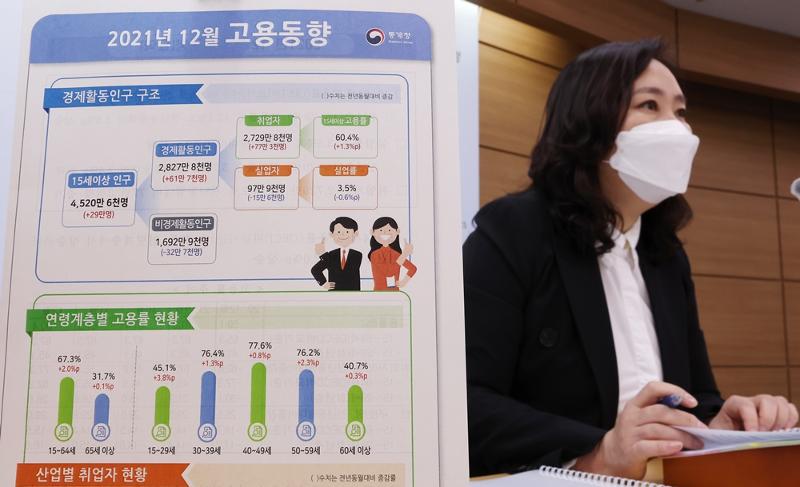
Kong Mi-suk, director-general of Statistics Korea's Social Statistics Bureau, on Jan. 12 announces employment trends last month and for all of 2021. (Yonhap News)
By Lee Jihae
The number of employed last year saw its biggest rise in seven years.
Statistics Korea on Jan. 12 said the number of employed last year reached 27,273,000, or 369,000 more than in 2020.
The rise was the highest since 598,000 in 2014.
In 2020, when the COVID-19 pandemic broke out, the number of employed plummeted 218,000 from 2019, the biggest drop in 22 years since 1,276,000 in 1998, when the Asian financial crisis rocked the country. The figure, however, returned to positive growth last year.
Kong Mi-suk, director-general of the Social Statistics Bureau at Statistics Korea, said, "The base effect in 2020, a year that saw a big drop in the number of employed due to COVID-19, and changes in the industrial structure such as contactless and digital transitions and export upswings led to continued employment recovery in 2021."
Last year, the service sector saw growth of 292,000 in the number of employed, followed by 13,000 in agriculture, forestry and construction; 54,000 in information and communications; 55,000 in professional services and science and technology; and 103,000 in transportation and storage. Services related to noncontact and digital transitions also saw growth in the number of staff, as did health and welfare (198,000).
Manufacturing, however, saw the number of employed decline 8,000. Service sectors requiring person-to-person contact also saw drops in labor including accommodations and food (47,000); wholesale and retail (150,000); arts, sports and leisure (29,000); and individual services (55,000).
The self-employed with staff suffered a decrease of 65,000 laborers, the third consecutive year of decline since 2019. Those with no workers saw the number rise 47,000. The number of permanent employees rose 366,000 and that of temps 152,000.
By age, the number of employed in their 20s grew 105,000 and that of those in their 50s 66,000; the figure for those in their 60s or above saw the highest rise of 330,000. In contrast, the figures for those in their 30s and 40s, two key demographics of the economy, declined 107,000 and 35,000, respectively.
The number of unemployed last year reached 1,037,000, or 71,000 fewer than in 2020, for a national jobless rate of 3.7%, down three-tenths of a percentage point from the year before.
jihlee08@korea.kr
Most popular
- Grammy-winning producer calls Suga of BTS 'amazing artist'
- 'Universal love, family' themes fuel success of 'King of Kings': director
- Council sets minimum hourly wage in 2026 at KRW 10,320
- Expansion of foreign app system raises tourist convenience
- Nat'l population diversity rose nearly 8% from 2018-22: study
